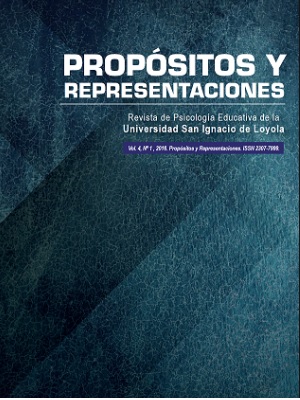Software GeoGebra en la mejora de capacidades resolutivas de problemas de figuras geométricas bidimensionales en universitarios
GeoGebra software in the improvement of solving capacities of problems of two-dimensional geometric figures in university students
##plugins.themes.bootstrap3.article.main##
El objetivo fue evaluar el efecto de la aplicación del software GeoGebra en las habilidades de resolución de problemas de figuras geométricas bidimensionales en una muestra de 53 estudiantes universitarios distribuidos en dos grupos (control – experimental) evaluados en dos momentos: antes y despues de la intervención. Se emplearon pruebas paramétricas para comparación de pares relacionados e independientes y no paramétricas para comparar entre los niveles de clasificación. Los resultados evidenciaron que el grupo experimental post test fue el que mejor rendimiento presentó demostrándose que el uso del software GeoGebra mejoró las habilidades resolutivas de ese tipo de problemas matemáticos fomentandose el trabajo colaborativo, integración socio estudiantil y mejora del clima de clase. Se recomienda ampliar el uso de esta herramienta con otras aplicaciones que coayuven el proceso de enseñanza aprendizaje.
##plugins.themes.bootstrap3.article.details##
Albano, G., & Dello Iacono, U. (2019). GeoGebrain e-learning environments: a possible integration in mathematics and beyond. Journal of Ambient Intelligence and Humanized Computing, 10(11), 4331–4343. https://doi.org/10.1007/s12652-018-1111-x
Alcívar-Castro, E., Zambrano Alcívar, K., Párraga Zambrano, L., Mendoza García, K., & Zambrano Villegas, Y. (2019). Software educativo GeoGebra. Propuesta de estrategia metodológica para mejorar el aprendizaje de las matemáticas.Revista Universidad Ciencia y Tecnología, 23(95), 59-65. https://bit.ly/2KyH6la
Antolin, J. (2010). Teoria de situaciones didacticas.México: Secretaría de Educación de Jalisco.
Arbain, N., & Shukor, N. A. (2015). The Effects of GeoGebraon Students Achievement. Procedia -Social and Behavioral Sciences, 172, 208–214. https://doi.org/10.1016/j.sbspro.2015.01.356
Avilés, J., Feliciano, A., Cuevas, R., & Alonso, G. (2015). Aplicación de GeoGebraen la determinación de máximos y mínimos en línea.CICOM, 1,186-189.
Bacher-Hicks, A., Goodman, J., & Mulhern, C. (2021). Inequality in household adaptation to schooling shocks: Covid-induced online learning engagement in real time. Journal of Public Economics, 193, 104345. https://doi.org/10.1016/j.jpubeco.2020.104345
Benavides, M., León, J., & Etesse, M. (2014). Desigualdades educativas y segregación en el sistema educativo peruano. Una mirada comparativa de las pruebas PISA 2000 y 2009. Grupo de Análisis Para El Desarrollo. http://dspace.concytec.gob.pe:80/xmlui/handle/GRADE/295
Brousseau, G. (2007). Iniciación al estudio de la teoría de las situaciones didácticas. Argentina: Libros del Zorzal.
Cascaes , F., Goncalves, E., Valdivia, B., Graziele, G., Da silva, T., Soleman, S., & Da Silva, R. (2015). Estimadores de consistencia interna en las investigaciones en salud: el uso del coeficiente alfa. Revista Peruana de Medicina Experimental y Salud Publica, 32(1), 129-138.
Castro, W. F., Pino-Fan, L. R., Lugo-Armenta, J. G., Toro, J. A., & Retamal, S. (2020). A Mathematics Education Research Agenda in Latin America Motivated by Coronavirus Pandemic. Eurasia Journal of Mathematics, Science and Technology Education, 16(12), em1919. https://doi.org/10.29333/ejmste/9277
Cui, V., O’Leary, M., Pressick, I., Reynolds, S., Roberts, L., Turville, N., & White, N. (2020). Learning about learning and teaching: developing classroom consciousness and reimagining collaboration between students and staff. PRACTICE, 2(2), 128–144. https://doi.org/10.1080/25783858.2020.1831737
Dalby, D., & Swan, M. (2019). Using digital technology to enhance formative assessment in mathematics classrooms. British Journal of Educational Technology, 50(2), 832–845. https://doi.org/10.1111/bjet.12606
Del Canto, E., & Silva, A. (2013). Metodología cualitativa: Abordaje desde la complementariedad en Ciencias sociales. Revista de Ciencias Sociales, III(141), 25-34.
Demirbilek, M., & Žilinskienė, I. (2015). Use of GeoGebrain Primary Math Education in Lithuania: An Exploratory Study from Teachers’ Perspective. Informatics in Education -An International Journal, 14(1), 129–144.
Díaz-Nunja, L., Rodríguez-Sosa, J., & Lingán, S. (2018). Enseñanza de la geometría con el software GeoGebraen estudiantes secundarios de una institución educativa en Lima. Propósitos y Representaciones, 6(2), 217-251. doi:10.20511/pyr2018.v6n2.251
Dikovic, L. (2009). Implementing Dynamic Mathematics Resources with GeoGebraat the College Level. International Journal of Emerging Technologies in Learning (IJET), 4(3), 51–54.
Ercan, O., & Ural, E. (2016). The Effect of Educational Software Based on Ausubel's Expository Learning on Students' Academic Achievement, Science and Computer Attitudes: "Human and Environment" Unit Example. British Journal of Education, Society & Behavioural Science, 14(1), 1-10.
Gavilanes, M., Yanza, W., Fabián, A., Torres, G., & Sánchez, R. (2019). Las TICs en los procesos de enseñanza y aprendizaje. Ciencia Digital, 3(2), 422-439.
Getha-Eby, T. J., Beery, T., Xu, Y., & O’Brien, B. A. (2014). Meaningful learning: Theoretical support for concept-based teaching. Journal of Nursing Education, 53(9), 494–500. https://doi.org/10.3928/01484834-20140820-04
Grisales, A. (2018). Uso de recursos TIC en la enseñanza de las matemáticas: retos y perspectivas. Esntramado, 14(2), 198-214. doi:10.18041/1900-3803/entramado.2.4751
Hegedus, S., & Moreno-Armella, L. (2020). Information and Communication Technology (ICT) Affordances in Mathematics Education. In S. Lerman (Ed.), Encyclopedia of Mathematics Education(pp. 380–384). Springer International Publishing. https://doi.org/10.1007/978-3-030-15789-0_78
Helou, M., & Newsome, L. (2018). Application of Lev Vygotsky’s Sociocultural Approach to Foster Students’ Understanding and Learning Performance. Journal of Education and Culture Studies, 2(4), 347-355.
Hernández, R. (2017). Impacto de las TIC en la educación: Retos y Perspectivas. Propósitos y Representaciones, 5(1). 10.20511/pyr2017.v5n1.149
Hernández-Sampieri, R., & Mendoza, C. P. (2018). Metodología de la investigación: Las rutas cuantitativa, cualitativa y mixta. Mc Graw Hill Education.
Horwitz, P., von Davier, A., Chamberlain, J., Koon, A., Andrews, J., & McIntyre,C. (2017). Teaching Teamwork: Electronics Instruction in a Collaborative Environment. Community College Journal of Research and Practice, 41(6), 341–343. https://doi.org/10.1080/10668926.2016.1275886
Iriarte, A. (2011). Desarrollo de la competencia de resolución de problemas desde una didáctica con enfoque metacognitivo. Revista del Instituto de Estudios en Educación Universidad del Norte, (15), 2-21. https://bit.ly/2JjgiEZ
Kaye, A. (1992). Learning Together Apart. In Collaborative Learning Through Computer Conferencing(pp. 1–24). Springer Berlin Heidelberg. https://doi.org/10.1007/978-3-642-77684-7_1
Kim, M. K., Xie, K., & Cheng, S. L. (2017). Building teacher competency for digital content evaluation. Teaching and Teacher Education, 66, 309–324. https://doi.org/10.1016/j.tate.2017.05.006
Lamb, R., & Etopio, E. A. (2020). Virtual Reality: a Tool for Preservice Science Teachers to Put Theory into Practice. Journal of Science Education and Technology, 29(4), 573–585. https://doi.org/10.1007/s10956-020-09837-5
Lavicza, Z. (2010). Integrating technology into mathematics teaching at the university level. ZDM-International Journal on Mathematics Education, 42(1), 105–119. https://doi.org/10.1007/s11858-009-0225-1
Manco-Chavez, J. A., Uribe-Hernandez, Y. C., Buendia-Aparcana, R., Vertiz-Osores, J. J., Isla Alcoser, S. D., & Rengifo-Lozano, R. A. (2020). Integration of ICTS and Digital Skills in Times of the Pandemic Covid-19. International Journal of Higher Education, 9(9), 11. https://doi.org/10.5430/ijhe.v9n9p11
Marginson, S. & Anh Dang, T. (2017) Vygotsky’s sociocultural theory in the context of globalization, Asia Pacific Journal of Education, 37(1), 116-129, Doi: 10.1080/02188791.2016.1216827
Mason, L. (2003). High School Students’ Beliefs about Maths, Mathematical Problem Solving, and their Achievement in Maths: A cross-sectional Study. Educational Psychology, 23(1), 73–85. https://doi.org/10.1080/01443410303216
Mazzilli, D., Hernández, L., & De la Hoz, S. (2016). Procedimiento para Desarrollar la Competencia Matemática Resolución de Problemas. Escenarios, 14(2), 103-119.
Minedu. (2016). Curriculo Nacional de la Educación Básica.
Minedu. (2020). Currículo Nacional Educativo. Ministerio de Educación. http://www.minedu.gob.pe/curriculo/
Ministerio de Educación. (2017). Docentes y sus aprendizajes en modalidad virtual. Lima: Minedu.
Mudaly, V., & Sheriff, R. (2016). Technology in mathematics: Use of GeoGebra. International Scientific Researchs Journal PONTE, 72(9), 190-212. doi:10.21506/j.ponte.2016.9.14
Mulenga, E. M., & Marbán, J. M. (2020). Is COVID-19 the Gateway for Digital Learning in Mathematics Education? Contemporary Educational Technology, 12(2), ep269. https://doi.org/10.30935/cedtech/7949
Niess, M. L. (2005). Preparing teachers to teach science and mathematics with technology: Developing a technology pedagogical content knowledge. Teaching and Teacher Education, 21(5), 509–523. https://doi.org/10.1016/j.tate.2005.03.006
Ocaña-Fernández, Y., Valenzuela-Fernández, L., & Morillo-Flores, J. (2020). La competencia digital en el docente universitario. Propósitos y Representaciones, 8(1), 455. https://doi.org/10.20511/pyr2020.v8n1.455
Oficina Regional de Educación para América Latina y el Caribe. (2013). Enfoque estratégico sobre TICs en educación en América Latina y El Caribe.Santiago de Chile: Acción Digital.
Orellana, G., & Vilcapoma, A. (2018). Aplicación de la teoría de Vigotsky al problema del aprendizaje en matemáticas. SociaLium, 2(1), 12-16. Doi:0.31876/sl.v2i1.4
Ortega-Sánchez, D., Gómez-Trigueros, I. M., Trestini, M., & Pérez-González, C. (2020). Self-Perception and Training Perceptions on Teacher Digital Competence (TDC) in Spanish and French University Students. Multimodal Technologies and Interaction, 4(4), 74. https://doi.org/10.3390/mti4040074
Pérez, J. (2015). El Positivismo y la investigación científica. Revista Empresarial, ICE-FEE-UCSG, 9(3), 29-34.
Radha, R., Mahalakshmi, K., Kumar, V. S., & Saravanakumar, A. R. (2020). E-Learning during Lockdown of Covid-19 Pandemic: A Global Perspective. International Journal of Control and Automation, 13(4), 1088–1099.
Rama, C. (2014). University virtualisation in Latin America. RUSC Universities and Knowledge Society Journal, 11(3), 33–43. https://doi.org/10.7238/rusc.v11i3.1729
Ramadhani, R., & Dahlya Narpila, S. (2018). Problem based learning method with GeoGebrain mathematical learning. International Journal of Engineering & Technology, 7(2), 774–777. https://www.researchgate.net/publication/327546788
Ramos, C. A. (2015). Scientific research paradigms. Av.Psicol, 23(1), 9–17.
Rohaeti, E. E., & Bernard, M. (2018). The students’ mathematical understanding ability through scientific-assisted approach of GeoGebrasoftware. Infinity Journal, 7(2), 165. https://doi.org/10.22460/infinity.v7i2.p165-172
Ropohl, M., Nielsen, J. A., Olley, C., Rönnebeck, S., & Stables, K. (2018). The Concept of Competence and Its Relevance for Science, Technology and Mathematics Education(pp. 3–25). Springer, Cham. https://doi.org/10.1007/978-3-319-63248-3_1
Rosa, M., & Pinheiro, R. P. (2020). Cybereducation with Mathematics Teachers: Working with Virtual Reality in Mathematics Activities. In B. M. Viggiani (Ed.), Constitution and Production of Mathematics in the Cyberspace(pp. 123–140). Springer, Cham. https://doi.org/10.1007/978-3-030-42242-4_8
Ruiz, H., Ávila, P., & Villa, J. (2012). Uso de GeoGebra como herramienta didáctica dentro del aula de matemáticas. Colombia: Editorial ITM.
Salazar, J. (2018). Evaluación de aprendizaje significativo y estilos de aprendizaje: Alcances, propuesta y desafíos en el aula. Tendencias pedagógicas(31), 31-46.
Sánchez, H., Reyes, C., & Mejía, K. (2018). Manual de términos en investigación científica, tecnológica y humanística. Lima: Universidad Ricardo Palma.
Santos-Trigo, M. (2020). Problem-Solving in Mathematics Education. In Encyclopedia of Mathematics Education(pp. 686–693). Springer International Publishing. https://doi.org/10.1007/978-3-030-15789-0_129
Saputra, E., & Fahrizal, E. (2019). The Development of Mathematics Teaching Materials through GeoGebraSoftware to Improve Learning Independence. Malikussaleh Journal of Mathematics Learning (MJML), 2(2), 2620–6323. https://doi.org/10.29103/mjml.v2i2.1860
Scagnoli, N. (2009). A Review of Online Learning and its Evolution in Latin America. Policy Futures in Education, 7(5), 555–565. https://doi.org/10.2304/pfie.2009.7.5.555
Septian, A., Darhim, & Prabawanto, S. (2020). GeoGebrain integral areas to improve mathematical representation ability. Journal of Physics: Conference Series, 1613(1), 12035. https://doi.org/10.1088/1742-6596/1613/1/012035
Septian, Ari, Inayah, S., Suwarman, R. F., & Nugraha, R. (2020). GeoGebra-Assisted Problem Based Learning to Improve Mathematical Problem Solving Ability. 67–71. https://doi.org/10.2991/assehr.k.200827.119
Septian, Ari, Sugiarni, R., & Monariska, E. (2020). The Application of Android-based GeoGebraon Quadratic Equations Material toward Mathematical Creative Thinking ability. Al-Jabar : Jurnal Pendidikan Matematika, 11(2), 261–272. https://doi.org/10.24042/ajpm.v11i2.6686
Simonetti, M., Perri, D., Amato, N., & Gervasi, O. (2020). Teaching Math with the Help of Virtual Reality. Lecture Notes in Computer Science (Including Subseries Lecture Notes in Artificial Intelligence and Lecture Notes in Bioinformatics), 12255 LNCS, 799–809. https://doi.org/10.1007/978-3-030-58820-5_57
Stacey, K., & Wiliam, D. (2013). Technology and assessment in mathematics. In Third International Handbook of Mathematics Education(pp. 721–751). Springer New York. https://doi.org/10.1007/978-1-4614-4684-2_23
Stenberg, L. C., Varua, M. E., & Yong, J. (2010). Mathematics Aptitude, Attitude, Secondary Schools and Student Success in Quantitative Methods for Business Subject in an Australian Catholic University Experience. Australian Catholic University Experience. 39th Australian Conference of Economists, 1–13. https://researchonline.nd.edu.au/bus_conference/26.
Suryani, A. I., Anwar, Hajidin, & Rofiki, I. (2020). The practicality of mathematics learning module on triangles using GeoGebra. Journal of Physics: Conference Series, 1470(1), 12079. https://doi.org/10.1088/1742-6596/1470/1/012079
Takači, D., Stankov, G., & Milanovic, I. (2015). Efficiency of learning environment using GeoGebrawhen calculus contents are learned in collaborative groups. Computers and Education, 82(3), 421–431. https://doi.org/10.1016/j.compedu.2014.12.002
Trgalová, J., Clark-Wilson, A., & Weigand, H.-G. (2018). Technology and resources in mathematics education. In Developing Research in Mathematics Education(pp. 142–161). Routledge. https://doi.org/10.4324/9781315113562-12
Vértiz-Osores, J. J., Vílchez Ochoa, G. L., Vértiz-Osores, R. I., Damián-Núñez, E., Chico Tasayco, H., & Rodríguez-Fuentes, A. (2019). Malestar docente: reflexiones frente al bajo rendimiento académico en estudiantes universitarios. Propósitos y Representaciones, 7(3), 273. https://doi.org/10.20511/pyr2019.v7n3.387
Vértiz Osores, J. J., Cucho Flores, R. R., Vértiz-Osores, R. I., Vílchez Ochoa, G. L., & Angulo Romero, A. (2020). Virtual university education in the context of the health emergency due to COVID-19: Challenges in the evaluation processes. International Journal of Early Childhood Special Education, 12(1), 467–477. https://doi.org/10.9756/INT-JECSE/V12I1.201027
Wijaya, T. T., Ying, Z., & Suan, L. (2020). Gender and Self Regulated Learning During COVID-19 Pandemic in Indonesia. Jurnal Basicedu, 4(3), 725–732. https://doi.org/10.31004/basicedu.v4i3.422
Zulnaidi, H., & Zamri, S. N. A. S. (2017). The effectiveness of the GeoGebrasoftware: The intermediary role of procedural knowledge on students’ conceptual knowledge andtheir achievement in mathematics. Eurasia Journal of Mathematics, Science and Technology Education, 13(6), 2155–2180. https://doi.org/10.12973/eurasia.2017.01219a















